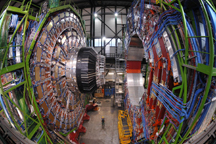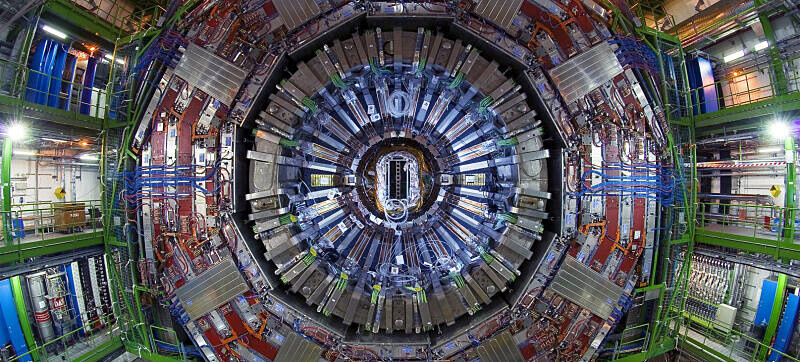May 5, 2020
Scientists ‘at the bleeding edge’ with upgrade to CMS detector
 The CMS detector. (Photo provided by CERN/Maximilien Brice)
Download image
The CMS detector. (Photo provided by CERN/Maximilien Brice)
Download image
Purdue particle physicists continue a legacy of boundary-pushing experiments at the Large Hadron Collider
WEST LAFAYETTE, Ind. — The huge detectors providing a window to the world’s tiniest particles are set for a $153 million upgrade, and a team of Purdue University scientists will play a key role — continuing the university’s decades-long legacy with the historic experiments at the European Organization for Nuclear Research, or CERN.
Over the next five years, the international collaboration will improve by tenfold the sensitivity of the Compact Muon Solenoid, or CMS, detector, and prepare it to endure radiation levels equivalent to the core of a nuclear reactor when CERN increases the intensity of the proton beams in the Large Hadron Collider (LHC) — the largest and most powerful particle accelerator in the world.
“The levels of radiation the detectors will face in this next phase of experiments presents a real challenge. We have to find materials that will survive this exposure for 10 years without turning to dust,” said Matthew Jones, the Purdue professor of physics and astronomy who is a principal investigator on the National Science Foundation-funded project led by Cornell University. “We are really at the bleeding edge, and the technological advances from this project will inform fields spanning space exploration, computer science and optics. But our goal is to understand the nature of the fundamental particles from which our world is built.”
From smashing particles at near the speed of light to the discovery of the Higgs particle and celebration of the Nobel Prize that followed, Purdue researchers have persistently pursued the science alongside their international colleagues at CERN.
Researchers are hopeful this next phase of the historic particle physics experiment opens the door to a deeper understanding of fundamental physical mysteries, like dark matter and the origins of the universe.
“We are trying to find new physics and to test the theoretical models,” said Andreas Jung, Purdue professor of physics and astronomy and co-principal investigator on the project. “When the LHC increases the intensity of the proton beams in 2027, it will create an order of magnitude more recorded collisions — perhaps even creating new particles never before seen. At the same time, the upgraded detectors will allow us to capture more of these events and with much better resolution than ever before.”
 The Compact Muon Solenoid detector is a general-purpose detector at the Large Hadron Collider (LHC) in Switzerland, designed to observe any new physics phenomena that the LHC might reveal. (Photo provided by CERN)
The Compact Muon Solenoid detector is a general-purpose detector at the Large Hadron Collider (LHC) in Switzerland, designed to observe any new physics phenomena that the LHC might reveal. (Photo provided by CERN)
The CMS detector is, in essence, a 14,000-ton extremely high-resolution camera the size of a four-story office building that almost completely surrounds one collision point of the LHC beams. Currently, the heart of the CMS detector is equipped with a high-resolution camera of 80 million individual silicon pixels. Every 25 nanoseconds debris from the collisions of protons in the beams passes through the pixels, and within it are traces of the lives of elementary particles created only for an instant as the protons are smashed into their constituent pieces.
The CMS upgrade will shrink the size of each silicon pixel and at the same time extend the detector coverage, with a total of 2 billion silicon pixels to be placed at the center of the upgraded detector. Just like the cameras on our phones, a sensor with more pixels produces sharper pictures, and the scientists will be able to see the creation, contributions and indirect effects of these fundamental particles in greater detail than ever before.
Purdue is the lead assembly center for the new silicon pixel modules of the inner silicon detector of the CMS and will oversee and coordinate the module assembly at other institutions.
In a clean-room facility in the Purdue Physics Building, robotic equipment has been programmed and tested to put together the sensors and circuit boards that form the pixel modules. The precision required is placement within 10 microns, or roughly one-fifth the diameter of a human hair, and high-density electrical connections with 10 wires per millimeter.
“This is the third generation of the CMS detector, and we’ve been involved in manufacturing the silicon pixel modules since the beginning,” Jones said. “In addition to precision robotics, we’re taking advantage of all of the advances in integrated circuit and computing technology over the past 10 years. For example, each sensor will have far more memory, so an image can be stored in the sensor until we are ready to read it out.”
Purdue also will design and manufacture the large carbon-fiber structures that support the entire tracking pixel detector. Not only will they face extreme levels of radiation, the custom-designed equipment also must be extremely lightweight, strong and thermally conductive. The structures must be able to support 50 times their weight in order to meet the specifications.
“The carbon fiber structures we design must be light, strong and quickly conduct any heat generated away from the detector,” said Abraham Mathew Koshy, a doctoral student in Jung’s research group. “We have to adapt different technology to our needs and develop new measurement techniques. What we do will not only benefit particle physics, it could be used in aircraft or spacecraft engineering or even to improve items we use every day.
“For me, the best part about working in physics is that it is a mixture of everything. It offers an understanding of the world and way to explain it scientifically.”
The LHC at CERN provides a crucial capability to answer important questions about the elementary constituents of matter and the fundamental forces that control their behavior at the most basic level. Starting in March 2010 when the first proton-proton collisions took place, the energy of the accelerator was steadily increased to enlarge the mass reach in the search for new particles. It is believed that the unprecedented energy range and sensitivity of the LHC combined with the special capabilities of the CMS experiment will lead to a breakthrough in our understanding of nature, Jung said.
Norbert Neumeister, Purdue physics and astronomy professor, is the group leader of the CMS experiment at Purdue and principal investigator of the Department of Energy-funded CMS research focused on analysis of the vast amounts of data.
“The LHC produces roughly 15 petabytes of data annually, or the equivalent of about 3 million DVDs per year, which thousands of scientists around the world access and analyze,” Neumeister said. “This massive data set has allowed the CMS collaboration to explore a wide range of particle physics phenomena.”
The LHC will restart its operation and collect data in 2021, at the same time the team works on the detector upgrades for the next phase of the experiment.
The National Science Foundation is providing $4.1 million to support the CMS pixel detector upgrade activities at Purdue led by Jones and Jung. In total more than 15 Purdue scientists and engineers are participating in these detector upgrade activities, including five doctoral and six undergraduate students.
The CMS Collaboration includes more than 4,000 particle physicists, engineers, computer scientists, technicians and students from institutes and universities in more than 40 countries.
Purdue’s Department of Physics and Astronomy is housed in the College of Science.
About Purdue University
Purdue University is a top public research institution developing practical solutions to today’s toughest challenges. Ranked the No. 6 Most Innovative University in the United States by U.S. News & World Report, Purdue delivers world-changing research and out-of-this-world discovery. Committed to hands-on and online, real-world learning, Purdue offers a transformative education to all. Committed to affordability and accessibility, Purdue has frozen tuition and most fees at 2012-13 levels, enabling more students than ever to graduate debt-free. See how Purdue never stops in the persistent pursuit of the next giant leap at purdue.edu.
Writer: Elizabeth K. Gardner
Media contact: Steve Tally, steve@purdue.edu, @sciencewriter
Sources: Matthew Jones, jones105@purdue.edu
Andreas Jung, anjung@purdue.edu
Norbert Neumeister, neumeist@purdue.edu
Abraham Koshy, amathewk@purdue.edu
Note to Journalists: Images of the CMS detector are available for journalists to use via a Google Drive folder.

